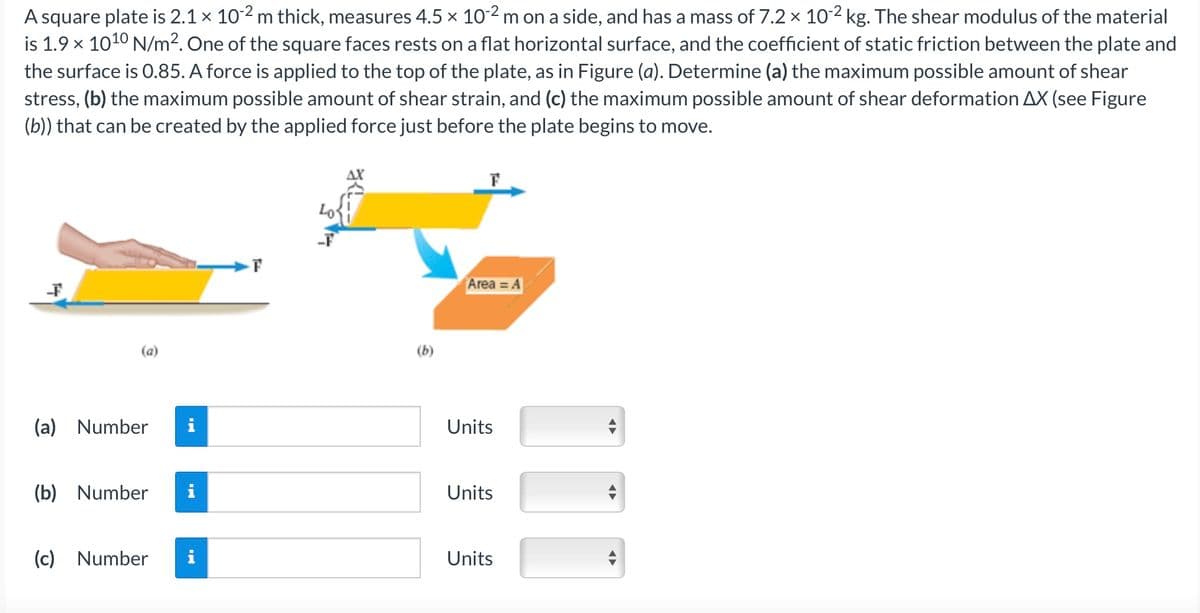A square plate is 2.1 × 102 m thick, measures 4.5 × 10-2 m on a side, and has a mass of 7.2 × 102 kg. The shear modulus of the material is 1.9 x 1010 N/m². One of the square faces rests on a flat horizontal surface, and the coefficient of static friction between the plate and the surface is 0.85. A force is applied to the top of the plate, as in Figure (a). Determine (a) the maximum possible amount of shear stress, (b) the maximum possible amount of shear strain, and (c) the maximum possible amount of shear deformation AX (see Figure (b)) that can be created by the applied force just before the plate begins to move. (a) (b) Area = A (a) Number i Units (b) Number Units (c) Number i Units
A square plate is 2.1 × 102 m thick, measures 4.5 × 10-2 m on a side, and has a mass of 7.2 × 102 kg. The shear modulus of the material is 1.9 x 1010 N/m². One of the square faces rests on a flat horizontal surface, and the coefficient of static friction between the plate and the surface is 0.85. A force is applied to the top of the plate, as in Figure (a). Determine (a) the maximum possible amount of shear stress, (b) the maximum possible amount of shear strain, and (c) the maximum possible amount of shear deformation AX (see Figure (b)) that can be created by the applied force just before the plate begins to move. (a) (b) Area = A (a) Number i Units (b) Number Units (c) Number i Units
Physics for Scientists and Engineers, Technology Update (No access codes included)
9th Edition
ISBN:9781305116399
Author:Raymond A. Serway, John W. Jewett
Publisher:Raymond A. Serway, John W. Jewett
Chapter12: Static Equilibrium And Elasticity
Section: Chapter Questions
Problem 12.28P: Assume Youngs modulus for bone is 1.50 1010 N/m2. The bone breaks if stress greater than 1.50 108...
Related questions
Question

Transcribed Image Text:A square plate is 2.1 × 102 m thick, measures 4.5 × 10-2 m on a side, and has a mass of 7.2 × 102 kg. The shear modulus of the material
is 1.9 × 1010 N/m². One of the square faces rests on a flat horizontal surface, and the coefficient of static friction between the plate and
the surface is 0.85. A force is applied to the top of the plate, as in Figure (a). Determine (a) the maximum possible amount of shear
stress, (b) the maximum possible amount of shear strain, and (c) the maximum possible amount of shear deformation AX (see Figure
(b)) that can be created by the applied force just before the plate begins to move.
(a)
F
Area = A
(a) Number
i
Units
(b) Number
Units
(c) Number
Units
Expert Solution
This question has been solved!
Explore an expertly crafted, step-by-step solution for a thorough understanding of key concepts.
Step by step
Solved in 3 steps with 3 images

Knowledge Booster
Learn more about
Need a deep-dive on the concept behind this application? Look no further. Learn more about this topic, physics and related others by exploring similar questions and additional content below.Recommended textbooks for you

Physics for Scientists and Engineers, Technology …
Physics
ISBN:
9781305116399
Author:
Raymond A. Serway, John W. Jewett
Publisher:
Cengage Learning

Physics for Scientists and Engineers: Foundations…
Physics
ISBN:
9781133939146
Author:
Katz, Debora M.
Publisher:
Cengage Learning

Physics for Scientists and Engineers
Physics
ISBN:
9781337553278
Author:
Raymond A. Serway, John W. Jewett
Publisher:
Cengage Learning

Physics for Scientists and Engineers, Technology …
Physics
ISBN:
9781305116399
Author:
Raymond A. Serway, John W. Jewett
Publisher:
Cengage Learning

Physics for Scientists and Engineers: Foundations…
Physics
ISBN:
9781133939146
Author:
Katz, Debora M.
Publisher:
Cengage Learning

Physics for Scientists and Engineers
Physics
ISBN:
9781337553278
Author:
Raymond A. Serway, John W. Jewett
Publisher:
Cengage Learning

Physics for Scientists and Engineers with Modern …
Physics
ISBN:
9781337553292
Author:
Raymond A. Serway, John W. Jewett
Publisher:
Cengage Learning

University Physics Volume 1
Physics
ISBN:
9781938168277
Author:
William Moebs, Samuel J. Ling, Jeff Sanny
Publisher:
OpenStax - Rice University

College Physics
Physics
ISBN:
9781938168000
Author:
Paul Peter Urone, Roger Hinrichs
Publisher:
OpenStax College